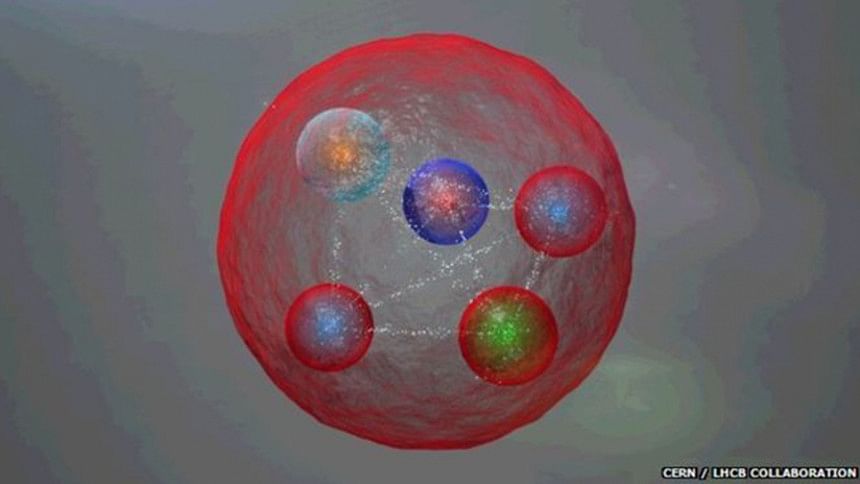Large Hadron Collider discovers new pentaquark particle

Scientists at the Large Hadron Collider have announced the discovery of a new particle called the pentaquark.
It was first predicted to exist in the 1960s but, much like the Higgs boson particle before it, the pentaquark eluded science for decades until its detection at the LHC.
The discovery, which amounts to a new form of matter, was made by the Hadron Collider's LHCb experiment.
The findings have been submitted to the journal Physical Review Letters.
In 1964, two physicists - Murray Gell Mann and George Zweig - independently proposed the existence of the subatomic particles known as quarks.

They theorised that key properties of the particles known as baryons and mesons were best explained if they were in turn made up of other constituent particles. Zweig coined the term "aces" for the three new hypothesised building blocks, but it was Gell-Mann's name "quark" that stuck.
This model also allowed for other quark states, such as the pentaquark. This purely theoretical particle was composed of four quarks and an antiquark (the anti-matter equivalent of an ordinary quark).
New states
During the mid-2000s, several teams claimed to have detected pentaquarks, but their discoveries were subsequently undermined by other experiments.
"There is quite a history with pentaquarks, which is also why we were very careful in putting this paper forward," Patrick Koppenburg, physics co-ordinator for LHCb at Cern, told BBC News.
"It's just the word 'pentaquark' which seems to be cursed somehow because there have been many discoveries that were then superseded by new results that showed that previous ones were actually fluctuations and not real signals."

Physicists studied the way a sub-atomic particle called Lambda b decayed - or transformed - into three other particles inside LHCb. The analysis revealed that intermediate states were sometimes involved in the production of the three particles.
These intermediate states have been named Pc(4450)+ and Pc(4380)+.
"We have examined all possibilities for these signals, and conclude that they can only be explained by pentaquark states," said LHCb physicist Tomasz Skwarnicki of Syracuse University, US.
Previous experiments had measured only the so-called mass distribution where a statistical peak may appear against the background "noise" - the possible signature of a novel particle.
But the collider enabled researchers to look at the data from additional perspectives, namely the four angles defined by the different directions of travel taken by particles within LHCb.
"We are transforming this problem from a one-dimensional to a five dimensional one... we are able to describe everything that happens in the decay," said Dr Koppenburg who first saw a signal begin to emerge in 2012.
"There is no way that what we see could be due to something else other than the addition of a new particle that was not observed before."

LHCb spokesperson Guy Wilkinson commented: "The pentaquark is not just any new particle… It represents a way to aggregate quarks, namely the fundamental constituents of ordinary protons and neutrons, in a pattern that has never been observed before in over fifty years of experimental searches.
"Studying its properties may allow us to understand better how ordinary matter, the protons and neutrons from which we're all made, is constituted."
The LHC powered up again in April following a two-year shutdown to complete a programme of repairs and upgrades.

 For all latest news, follow The Daily Star's Google News channel.
For all latest news, follow The Daily Star's Google News channel. 



Comments